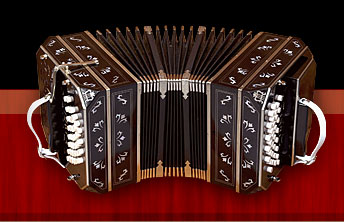


Where did The Bandoneón come from?
As mentioned, The Bandoneón was born in Germany in the middle of the 19th Century. Around 1870 the first instruments arrived in Argentina, just when Tango music was in its infancy. As soon as it was added to the Tango ensembles that were being formed in 1910 and 1920, it quicly became indispensable. Argentina became the largest importer of Bandoneóns at least until the end of the 1930s.
Bandoneón mass production pretty much stopped during WWII in Germany and there were no new factories until the end of the 1990s, when the Paul Fischer KG Company, a musical instrument manufacturer, dating back to 1887, set about reviving the manufacture of Bandoneóns in conjunction with the Eibenstock municipal authorities. The Paul Fischer KG Company, together with the Institute for the Manufacture of Musical Instruments of Zwota, developed a 142 tone Bandoneón with "Rheinsiche Tonlage" in 2001. The materials and construction used correspond to the legendary "AA" instruments.
The only museum dedicated to the Bandoneón is located in Carlsfeld, Germany. In Buenos Aires, the Academia Nacional del Tango displays the Bandoneón played by Anibal Troilo.
Today, we can find Bandoneóns that are being sold on the Internet and Tango Ensembles that include a Bandoneón player can be found in the USA, Japan, Turkey, Finland and France, just to name a few countries.
So, now you need to go to a "Milonga," a social tango dance, and actually hear a bandoneon played. There is no sound like the live Tango orchestra comprised of three violins, a viola, a piano, a bass and the magical Bandoneon!